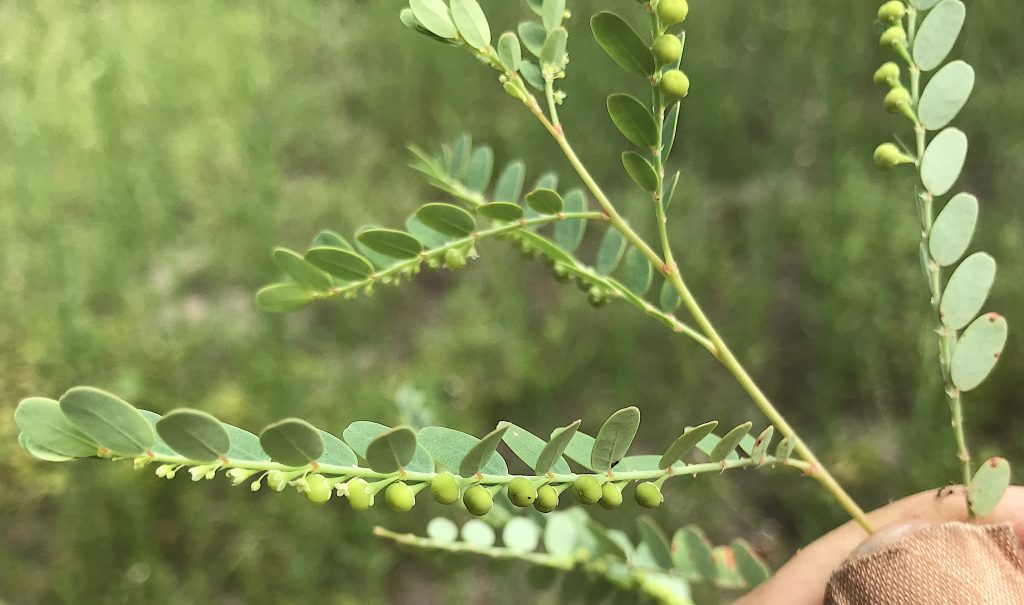
Chamberbitters, Phyllanthus urinaria, is medicinal not edible. We don’t cover herbals here because I am not qualified to talk about them much. However I know this one has a lot of good reserch behind it. This plant is a rich source of lignans, tannins, flavonoids, phenolics, terpenoids, and other secondary metabolites. Pharmacological activities include anticancer, hepatoprotective, antidiabetic, antimicrobial, and cardioprotective effects. As a point of identification note the seeds line up on the bottom of the stem. You can read about it here. Photo by Green Deane
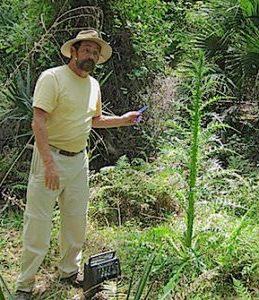
Foraging classes are three hours outside. Photo by Nermina Krenata
First an apology to those who showed up for a class last Sunday at Haul Over Canal to find, like me, the road closed. I was on the north side and most of the students on the south side. I had called Canaveral National Seashore and Merritt Island Refuge and was assured it was open. The closure apparently had something to do with activities at the space center. Federal property is always unreliable. This is also why I am canceling a class this weekend in Deland. I had a class scheduled at Lake Woodruff National Wildlife Refuge but three out of the last four last times there it was closed and this was before Covid. Also there is a high probability of heavy rain this Sunday. So take holiday weekend off. My current class schedule is:
Saturday, July 11th, Dreher Park, 1200 Southern Blvd., West Palm Beach, 33405, 9 a.m. to noon. Meet just north of the science center.
Sunday, July 12th, Mead Garden: 1500 S. Denning Dr., Winter Park, FL 32789, 9 a.m to noon. Meet in the parking lot near the bathrooms. The entrance to the park is on the west side off Denning Avenue. Many GPS direct you to an old, closed entrance on the east side on S. Pennsylavania Ave.
Saturday, July 18th, Red Bug Slough Preserve, 5200 Beneva Road, Sarasota, FL, 34233. 9 a.m. to noon. We meet at the picnic table by the kids’ play area.
Sunday, July 19th, Boulware Springs Park, 3420 SE 15th St., Gainesville, FL 32641. 9 a.m. to noon. We meet at the picnic table near the spring house. I am presuming the bike area still has Port-o-Lets open.
For more information, to pre-pay or sign up for a class go here.
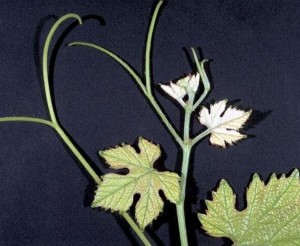
Forked-tendril species produce better grapes. Photo by Green Deane
What about grapes? There are basically three kinds of grapes in Florida. The two main ones are single tendril with pointy, hairless leaves, and forked tendrils with hand-sized fuzzy leaves. The former have clusters of grapes, they are often acidic, and they fruit irregularly. The latter are bunch grapes, smaller than commercial varieties and they fruit regularly. The single-tendrils can fruit from late June to early October or later. The forked tendrils tend to be about September. The third group is uncommon and is the product of hybridizing a century ago or so. They have the leaf of the single-tendril but have a forked tendril and produce bunches regularly. These are often found around old habitations or inns, resorts, train stations and the like. Unlike most grapes all are immune to Pierce’s disease which is lethal to over 300 species of grape. You can read about them here.
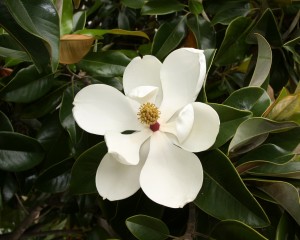
Magnolia grandiflora blossom
Forty-five years ago I was a foreign exchange student attending Whiteland College which was part of the University of London. I remember well four things about my time there. One was that they use Magnolia blossoms as a condiment. I thought that strange at the time. It’s a very intense flavor. You can make it yourself by dicing then lacto-fermenting the blossoms for a few days, draining, then storing it in the frig adding a little white wine and sugar helps. You can do the same thing with Nasturtium seeds. They smell horribly for three days but they taste great once drained and stored. You can also flavor vinegar with the white blossom petals (not as good I think.)
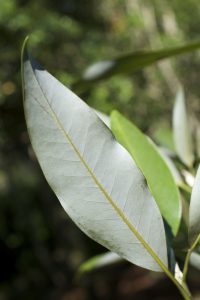
Magnolia virginiana leaves are easy to identify.
Magnolia grandiflora leaves can be used like a bay leaf. In fact a close relative, the “Sweet Bay,” Magnolia virginiana, has been used that way for at least centuries and is highly esteemed for that use. The “Sweet Bay” a very common tree in damp areas and easy to identify. You can read about the Magnolias here. And what were the other three memorable items from the exchange? All the hallways in the college — which is now an upscale condominium — were named after local streets. So you didn’t live in room 213. It was 213 Wadsworth Way. The college had a ratio of ten to one women and its patron saint was St. Ursula, the saint of virgins which might explain why the college no longer exists. And right across the hedgerow was a hospital with the most awful name on a huge wrought iron banner over the drive way. It was: The Royal Hospital for the Incurably Ill.
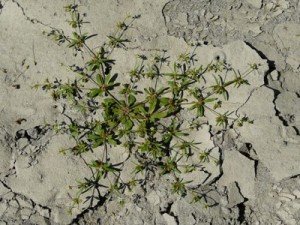
Carpetweed is hearty
One of the more common edible weeds underfoot in North America is Carpetweed, Mollugo verticillata. Scraggly if not scrawny the wispy plant does have the saving grace that it is all edible, raw or cooked and it requires very little cooking. Add it last. There are several non-edible species that can resemble it so there are some of key points to remember. First, it does not have any white sap, it grows in a circular mat, and the blossoms have five white sepals but usually only three stamens, sometimes four or five but usually three, which is a bit odd for a five-sepal plant. Look for it in dry, sandy locations including waste ground. For all of its wide-spread presence in North America it is actually native to the tropical Americas. You can read about Carpetweed here.

Green Deane videos are now available on a USB.
Changing foraging videos: My nine-DVD set of 135 videos has been selling for seven years. They are the same videos I have on You Tube. Some people like to have a separate copy. The DVD format, however, is becoming outdated. Those 135 videos plus 15 more are now available on a 16-gig USB drive. While the videos can be run from the DVDs the videos on the USB have to be copied to your computer to play. They are MP4 files. The150-video USB is $99 and the 135-video DVD set is now $99. The DVDs will be sold until they run out then will be exclusively replaced by the USB. This is a change I’ve been trying to make for several years. So if you have been wanting the 135-video DVD set order it now as the price is reduced and the supply limited. Or you can order the USB. My headache is getting my WordPress Order page changed to reflect these changes. We’ve been working on it for over three weeks. However, if you want to order now either the USB or the DVD set make a $99 “donation” using the link at the bottom of this page or here. That order form provides me with your address, the amount — $99 — tells me it is not a donation and in the note say if you want the DVD set or the USB.

Green Deane Forum
Want to identify a plant? Perhaps you’re looking for a foraging reference? You might have a UFO, an Unidentified Flowering Object, you want identified. On the Green Deane Forum we — including Green Deane and others from around the world — chat about foraging all year. And it’s not just about warm-weather plants or just North American flora. Many nations share common weeds so there’s a lot to talk. There’s also more than weeds. The reference section has information for foraging around the world. There are also articles on food preservation, and forgotten skills from making bows to fermenting food.
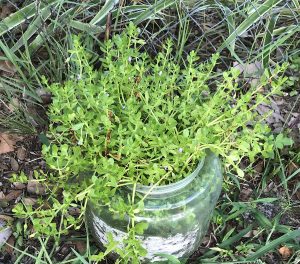
Bitter Bacopa. Photo by Green Deane
The question was: Can you grow Bacopa in a pot? If you give it water and sun it will take over the pot. A little 6-6-6- fertilizer also keeps it happy. If rain is regular you don’t have to water it. Other wise it will dry out so you do have to keep an eye on that. One other small issue: If your deep pot is not yet well populated lizards can fall in and drown. While that is fertilizer for the plants it does alter the bitter taste of the plant some. I usually leave a small branch in the pot for the hapless reptiles to crawl out on. Why raise Bacopa? It’s grows all year and helps some people with memory problems. You can read about it and it’s relatives here.
This is weekly newsletter 412, If you want to subscribe to this free newsletter you can find the sign-up form in the menu at the top of the page.
To donate to the Green Deane Newsletter click here.

